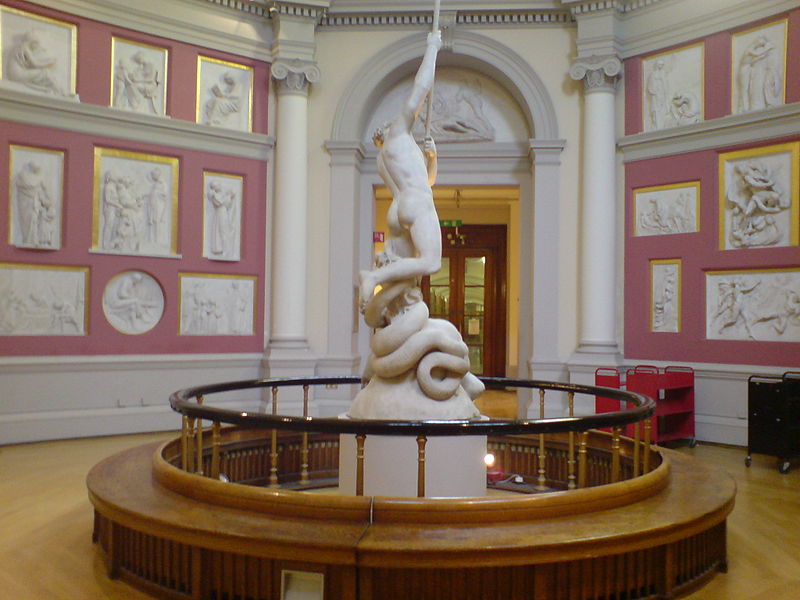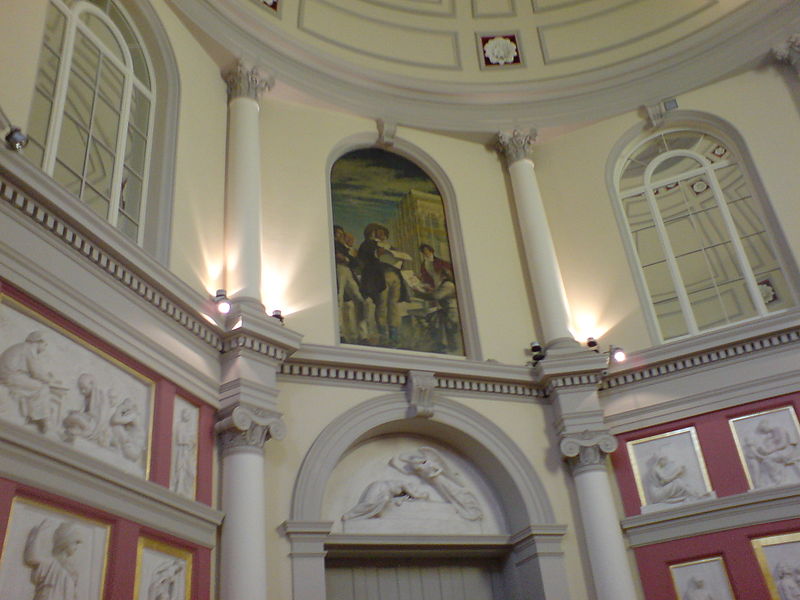<Back to Index>
- Sculptor and Draughtsman John Flaxman, 1755
PAGE SPONSOR
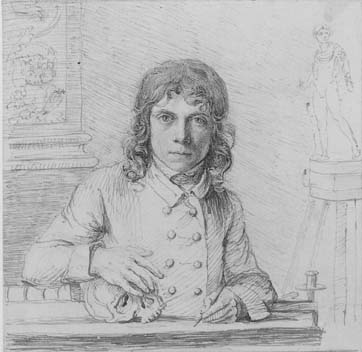
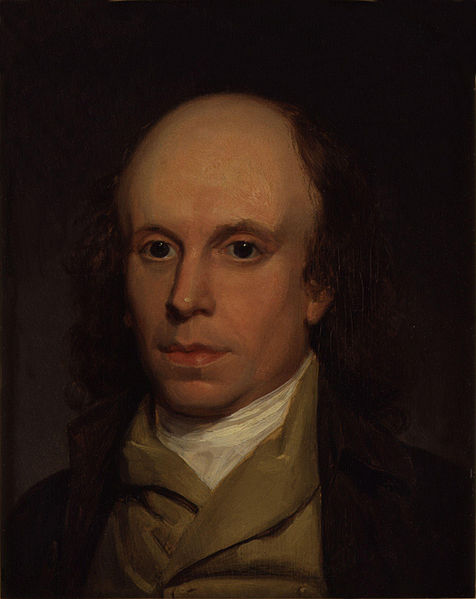
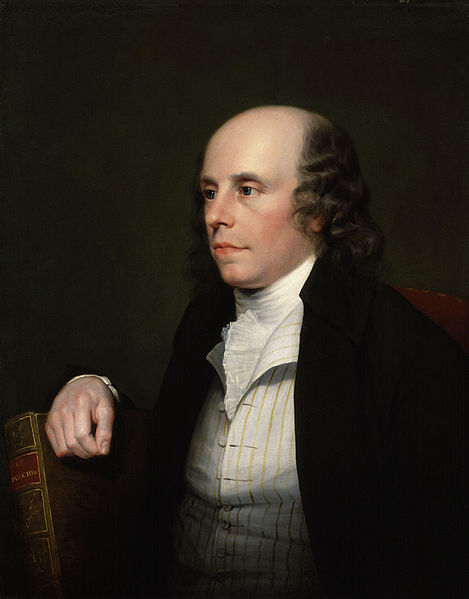
John Flaxman (6 July 1755 – 7 December 1826) was a British sculptor and draughtsman.
He was born in York. His father was also named John, after an ancestor who, according to family tradition, had fought for Parliament at the Battle of Naseby, and afterwards settled as a carrier or farmer in Buckinghamshire. John Flaxman the father was well known as a moulder and seller of plaster casts at the sign of the Golden Head, New Street, Covent Garden, London. His wife's maiden name was Lee, and John was their second son. Within six months of his birth the family returned to London. He was a sickly child, and his figure was high - shouldered, his head too large for his body. His mother died when he was nine, and his father re-married. He had little schooling, and was largely self educated. He took delight in drawing and modeling from his father's stock - in - trade, and studied translations from classic literature in an effort to understand them.
Customers of his father took a fancy to the child, and helped him with books, advice and later with commissions. Particular admirers from his youth were the painter George Romney, and a cultivated clergyman, Anthony Stephen Mathew and his wife Mrs. Mathew, in whose house in Rathbone Place the young Flaxman used to meet the best "blue - stocking" society of the day and, among associates of his own age, the artists William Blake and Thomas Stothard, who became his closest friends. He had already begun to work in clay as well as in pencil. At 12 years of age he won the first prize of the Society of Arts for a medallion, and became a public exhibitor in the gallery of the Free Society of Artists; at 15 he won a second prize from the Society of Arts and began to exhibit at the Royal Academy. In the same year, 1770, he entered as an Academy student and won the silver medal. Not all of his artistic endeavors resulted in success however. In the competition for the gold medal of the Academy in 1772, Flaxman was defeated, the prize being awarded by the president, Sir Joshua Reynolds, to a competitor named Engleheart. Rather than being a discouragement, this episode seemed to help cure Flaxman of a tendency to conceit, about which Thomas Wedgwood said of him in 1775, "It is but a few years since he was a most supreme coxcomb."
He continued to work diligently, both as a student and as an exhibitor at the Academy, with occasional attempts at painting. To the Academy he contributed a wax model of Neptune (1770); four portrait models in wax (1771); a terracotta bust, a wax figure of a child, an historical figure (1772); a figure of Comedy; and a relief of a Vestal (1773). During this period he received a commission from a friend of the Mathew family for a statue of Alexander the Great, but he was unable to obtain a regular income from private contracts. When he was 19 years old he was employed by Josiah Wedgwood and his partner Bentley, as a modeler of classic and domestic friezes, plaques, ornamental vessels and medallion portraits. It was in these inventive "jasper" and "basalt" ware compositions that the manufacturers of the age, who had conceived and perfected the style, earned their great reputation.
In the same year, 1775, John Flaxman the elder moved from New Street to a
bigger house at no. 420 the Strand. For 12 years Flaxman junior lived
chiefly by his work for the Wedgwood company. The beauty of the product
is undeniable, and the skills which Flaxman acquired in the delicacies
of modeling in low relief and on a minute scale were invaluable. By
1780 Flaxman had also begun to earn money by sculpting grave monuments.
His early memorial work included monuments for Thomas Chatterton in the church of St Mary Redcliffe in Bristol (1780), Mrs Morley in Gloucester Cathedral (1784), and the Rev. T and Mrs Margaret Ball in Chichester Cathedral (1785). During the rest of Flaxman's career memorial bas reliefs
of this type made up the bulk of his output; and may be found in many
churches throughout England. One example, the monument to George Steevens originally in St Matthais Old Church, is now to be found in the Fitzwilliam Museum, Cambridge. His best monumental work is admired for its pathos and simplicity, and
for the alliance of a truly Greek instinct for rhythmical design and
composition with the spirit of domestic tenderness and innocence that is
one of the secrets of the modern soul.
In 1782, aged 27, Flaxman married Anne Denman, who assisted him throughout his career. She was well educated, and the devoted companion of her husband's fortunes and of his travels. They set up house in Wardour Street, and usually spent their summer holidays as guests of the poet Hayley, at Eartham in Sussex. After five years, in 1787, they found themselves with means enough to travel, and set out for Rome, where they took up their quarters in the Via Felice.
Records of Flaxman's residence in Italy exist in the shape of drawings and studies. He stopped modeling for Wedgwood, but continued to direct the work of other modelers employed for the manufacture at Rome. He had intended to return after a stay of a little more than two years, but was detained by a commission for a marble group of a Fury of Athamas, a commission attended in the sequel with circumstances of infinite trouble and annoyance, from the notorious Comte - Evéque, Frederick Augustus Hervey, 4th Earl of Bristol.
He did not, as it turned out, return until the summer of 1794, after
an absence of seven years, having in the meantime executed another ideal
commission (a "Cephalus and Aurora") for Thomas Hope, and having sent home models for several sepulchral monuments, including one in relief for the poet William Collins in Chichester cathedral, and one in the round for Lord Mansfield in Westminster Abbey.
What gained Flaxman his general fame was not his work in sculpture proper, but those outline designs to the poets, in which he showed not only to what purpose he had made his own the principles of ancient design in vase paintings and bas reliefs, but also by what a natural affinity, better than all mere learning, he was bound to the ancients and belonged to them. The designs for the Iliad and Odyssey were commissioned by Mrs Hare Naylor; those for Dante by Hope (originally published in London in 1807); those for Aeschylus by Lady Spencer; they were all engraved by Piroli, not without considerable loss of the finer and more sensitive qualities of Flaxman's own lines. In fact, Flaxman's 110 illustrations of Dante's Divine Comedy are known as one of his greatest achievements: deceptively simple, awash with pathos, and recalling antique imagery in a classical Greek style, they themselves became an inspiration for such artists as Goya and Ingres, and were used as an academic source for 19th century art students.
During their homeward journey the Flaxmans traveled through central
and northern Italy. On their return they took a house in Buckingham
Street, Fitzroy Square. Immediately afterwards the sculptor published a
spirited protest against the scheme already entertained by the Directory, and carried out two years later by Napoleon, of equipping at Paris a vast central museum of art with the spoils of conquered Europe.
The rest of Flaxman's life was uneventful, and his work brought sufficient rewards and a good reputation, being praised by Antonio Canova, Schlegel and Henry Fuseli. He took as his pupil a son of William Hayley's, who became ill and died. In 1797 he was made an associate of the Royal Academy. Every year he exhibited work of one class or another: occasionally a public monument in the round, like those of Pasquale Paoli (1798) or Captain Montague (1802) for Westminster Abbey, of Sir William Jones for University College, Oxford (1797 – 1801), of Nelson or Howe for St Paul's Cathedral; more often memorials for churches, with symbolic Acts of Mercy or illustrations of Scripture texts, both commonly in low relief (1801), Miss Cromwell, Chichester (1800), Mrs Knight, Milton, Cambridge (1802), and many more; and these pious labors he would vary from time to time with a classical piece like those of his earliest predilection. Soon after his election as associate, he published a scheme, half grandiose, half childish, for a monument to be erected on Greenwich Hill, in the shape of a Britannia 200 ft (61 m). high, in honor of the naval victories of his country.
In 1800 he was elected a full Academician. During the peace of Amiens he went to Paris to see the despoiled treasures collected there, but bore himself according to the spirit of protest that was in him. The next event which makes any mark in his life is his appointment to a chair specially created for him by the Royal Academy, the chair of Sculpture: this took place in 1810. There is ample evidence of his thoroughness and judiciousness as a teacher in the Academy schools, and his professorial lectures have been often reprinted. With many excellent observations, and with one singular merit — that of doing justice, as in those days justice was hardly ever done, to the sculpture of the medieval schools — these lectures lack point and felicity of expression, just as they are reported to have lacked fire in delivery, and are somewhat heavy reading. The most important works that occupied Flaxman in the years next following this appointment were the monument to Mrs Baring in Micheldever church, the richest of all his monuments in relief (1805 – 1811); that for the Worsley family at Campsall church, Yorkshire, which is the next richest; those to Sir Joshua Reynolds for St Paul's (1807); to Captain Webbe for India (1810); to Captains Walker and Beckett for Leeds (1811); to Lord Cornwallis for Prince of Wales's Island (1812); and to Sir John Moore for Glasgow (1813). At this time the antiquarian world was much occupied with the vexed question of the merits of the Elgin marbles, and Flaxman was one of those whose evidence before the parliamentary commission had most weight in favor of the purchase which was ultimately effected in 1816.
After his Roman period he produced fewer outline designs for the engraver except three for William Cowper's translations of the Latin poems of John Milton (1810). Other sets of outline illustrations drawn about the same time, but not published, were one for the Pilgrim's Progress, and one for a Chinese tale in verse, "The Casket", which he wrote himself for his family. In 1817 we find him returning to his old practice of classical outline illustrations and publishing the happiest of all his series in that kind, the designs to Hesiod, excellently engraved by the sympathetic hand of Blake, Immediately afterwards he was much engaged designing for the goldsmiths — a testimonial cup in honor of John Kemble, and following that, the famous and beautiful (though quite un-Homeric) "Shield of Achilles". Almost at the same time he undertook a frieze of "Peace, Liberty and Plenty," for the Duke of Bedford's sculpture gallery at Woburn Abbey, and an heroic group of Michael overthrowing Satan, for Lord Egremont's Petworth House. His literary industry at the same time is shown by several articles on art and archaeology contributed to article and drawings on sculpture to Rees's Cyclopaedia (1802 - 1819).
He was commissioned to create the monument to Matthew Boulton (died 1809), by Boulton's son, which is on the north wall of the sanctuary of St. Mary's Church, Handsworth, Birmingham, where Boulton is buried. It includes a marble bust of Boulton, set in a circular opening above two putti, one holding an engraving of the Soho Manufactory.
In 1820 Flaxman's wife died. Her younger sister, Maria Denman, and his own sister, Maria Flaxman, continued to live with him, and he continued to work hard. In 1822 he delivered at the Academy a lecture in memory of his old friend and generous fellow craftsman, Canova, then recently dead; in 1823 he received a visit from Schlegel, of which the latter wrote an account. From an illness occurring soon after this he recovered sufficiently to resume both work and exhibition, but on 3 December 1826, he caught cold in church, and died four days later, in his 72nd year. Among a few intimate associates, he left a memory singularly dear; having been in companionship, although susceptible and obstinate when his religious creed — a devout Christianity with Swedenborgian admixtures — was crossed or slighted, yet in other things genial and sweet tempered beyond most men, full of modesty and playfulness and withal of a homely dignity, a true friend and a kind master, a pure and blameless spirit.
Flaxman's complicated monuments in the round, such as the three in
Westminster Abbey and the four in St Paul's Cathedral, are considered
too "heavy";
but his simple monuments in relief are of finer quality. He thoroughly
understood relief, and it gave better scope for his particular talents.
His compositions are best studied in the casts from his studio sketches,
of which a comprehensive collection is preserved in the Flaxman gallery
at University College, London.
Going back to the rudiments and first conceptions of his art helps to
realize the essential charm of his genius in the study, not of his
modeled work at all, but of his sketches in pen and wash on paper. The principal public collections are at University College, in the British Museum and the Victoria and Albert Museum.
